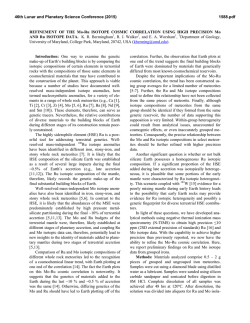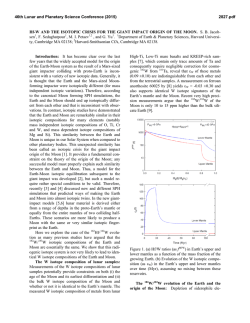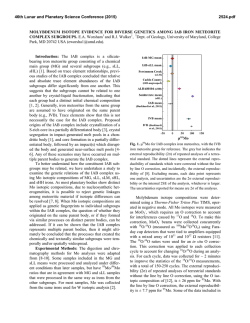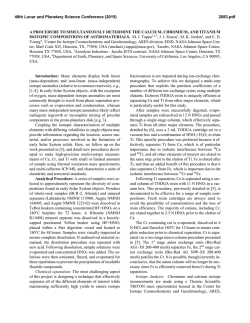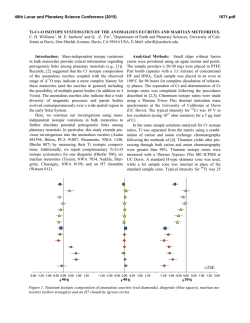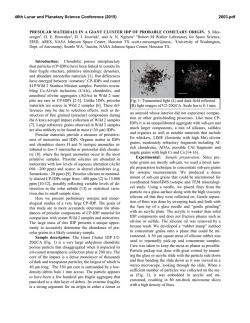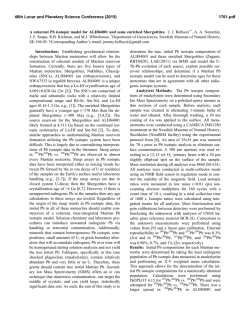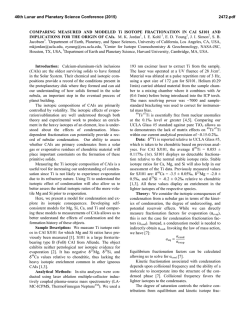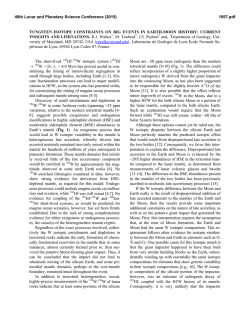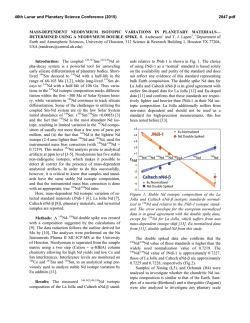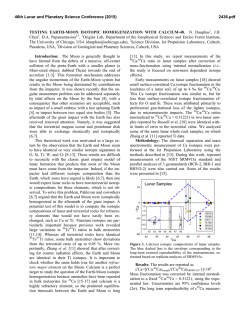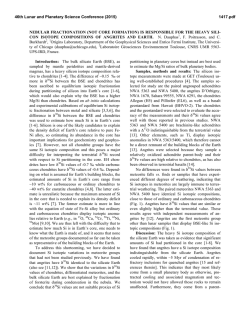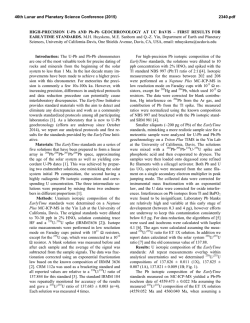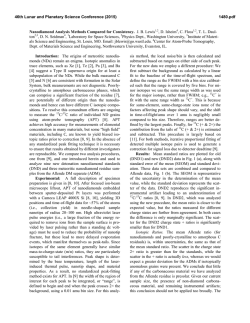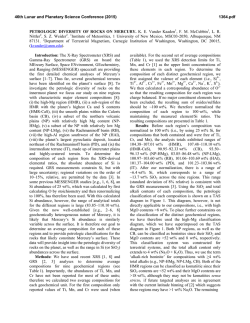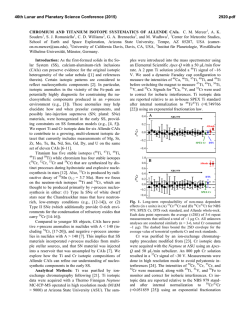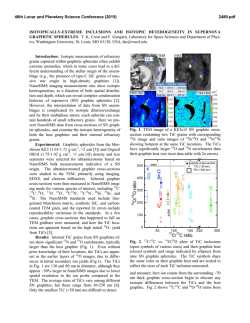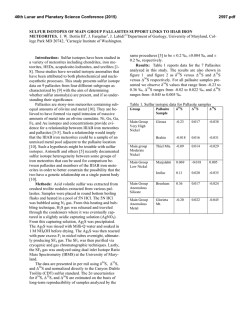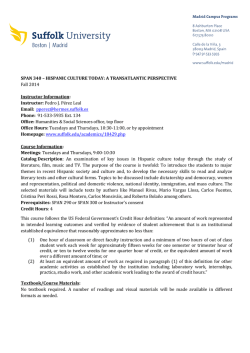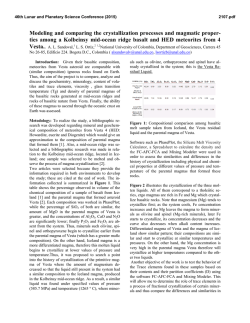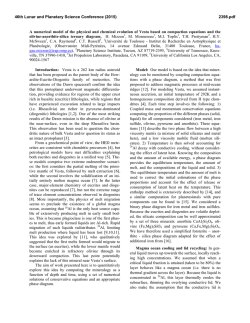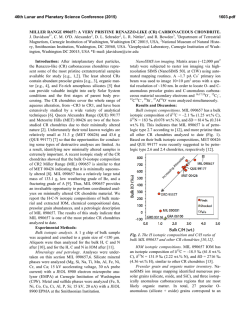
lead isotope compositions of acid residues from - USRA
46th Lunar and Planetary Science Conference (2015) 1921.pdf LEAD ISOTOPE COMPOSITIONS OF ACID RESIDUES FROM OLIVINE-PHYRIC SHERGOTTITE TISSINT: IMPLICATIONS FOR HETEROGENEOUS SHERGOTTITE SOURCE RESERVOIRS. R. Moriwaki1, T. Usui1, T. Yokoyama1, J. I. Simon2, and J. H. Jones3, 1Dept. of Earth and Planet. Sci., Tokyo Institute of Technology, 2-12-1 Ookayama, Meguro, Tokyo 152-8551, Japan ([email protected]), 2Center for Isotope Cosmochemistry and Geochronology at ARES, NASA-JSC, Houston, TX 77058, USA, 3ARES, NASA-JSC, Houston, TX 77058, USA. Introduction: Geochemical studies of shergottites suggest that their parental magmas reflect mixtures between at least two distinct geochemical source reservoirs, producing correlations between radiogenic isotope compositions and trace element abundances [e.g., 1-4]. These correlations have been interpreted as indicating the presence of a reduced, incompatibleelement-depleted reservoir and an oxidized, incompatible-element-enriched reservoir. The former is clearly a depleted mantle source, but there is ongoing debate regarding the origin of the enriched reservoir. Two contrasting models have been proposed regarding the location and mixing process of the two geochemical source reservoirs: (1) assimilation of oxidized crust by mantle derived, reduced magmas [2], or (2) mixing of two distinct mantle reservoirs during melting [3]. The former requires the ancient Martian crust to be the enriched source (crustal assimilation), whereas the latter requires isolation of a long-lived enriched mantle domain that probably originated from residual melts formed during solidification of a magma ocean (heterogeneous mantle model [5]). This study conducts Pb isotope and trace element concentration analyses of sequential acid-leaching fractions (leachates and the final residues) from the geochemically depleted olivine-phyric shergottite Tissint. The results suggest that the Tissint magma is not isotopically uniform and sampled at least two geochemical source reservoirs, implying that either crustal assimilation or magma mixing would have played a role in the Tissint petrogenesis. Sample: Tissint is the first witnessed fall of an olivine-phyric shergottite [6], and it consists of megacrysts of olivine and prismatically zoned pyroxene crystals. The groundmass is composed of finergrained crystals of olivine, pyroxene, plagioclase, and minor amounts of spinel, ilmenite, sulfide, and phosphate. The whole-rock composition exhibits a geochemically depleted signature; e.g., ε143Nd = +44.4 at the time of crystallization, 472 Ma [7]. Analytical Method: We prepared four Tissint whole-rock powders with a highly-pure quartz mortar and pestle (labeled as Tissint-A, -B. -C and -D); Tissint-C contains more impact glass fragments than the other three. These powders have total masses of 173 mg, 155 mg, 156 mg, and 182 mg, respectively. Five-step sequential acid leaching experiments were conducted on these whole-rock powders (Table 1). One-tenth of each leachate (L1-L5) and residue (R) was used for trace element concentration analysis by a quadrupole type ICP-MS (X series II, Thermo-Fisher Scientific) at Tokyo Tech. The remainder of each fraction containing sufficient Pb (>~1 ng) was processed for Pb isotope analyses by TIMS (Triton-plus, Thermo-Fisher Scientific) at Tokyo Tech. Chemical purification and mass spectrometry followed the established 207 Pb-204Pb double spike method [8, 9]. The average for NIST SRM981 measured during this study (n = 5) yielded 206Pb/204Pb = 16.940, 207Pb/204Pb = 15.497, and 208 Pb/204Pb = 36.716, respectively, consistent with the long-term averages measured at Tokyo Tech. Table 1. Protocol of acid leaching experiment Heating Step Reagent Temperature Time L1 H2O 30min ~20°C (room temp) L2 L3 L4 L5 R acetone 0.5M HBr 30min 1h ~20°C (room temp) 100°C 1M HF 1h 120°C 5M HCl 1h 120°C Dissolved in HF and HBr for Pb isotope analysis (+HClO4 for trace element) Each leaching step follows a 30 min. ultrasonic bath in MilliQ® water. Results and Discussion: Initial Pb isotopic compositions of leachates and residues were calculated based on the assumption that Tissint has a crystallization age of 472 Ma [7]. Some previous chronological studies based on the 207Pb-206Pb isotopic systematics have proposed ancient crystallization ages for the shergottite suite (e.g. 4.3 Ga for the geochemically depleted shergottites [10]). We employ the young SmNd age for Tissint because it is consistent with the LuHf and Rb-Sr internal isochron ages [e.g., 7]. Lead Isotopic Compositions: Initial Pb isotopic compositions of residues and their leachates exhibit significant spread in a 206Pb/204Pb-207Pb/204Pb isotope diagram (Fig. 1). The leachates have more radiogenic initial Pb isotopic compositions than those of residues; all of them plot almost linearly in this diagram. This linear variation is interpreted as being a mixing of two 46th Lunar and Planetary Science Conference (2015) components. An analogous mixing trend in a 207 Pb/206Pb-208Pb/206Pb isotope diagram obtained by preliminary ion microprobe measurements has been used to imply assimilation of a geochemically enriched crustal component by the geochemically depleted Tissint parental magma. However, it is not evident whether the enriched component represented by the leachates (this study) reflects an ancient Martian crustal reservoir or a terrestrial contaminant; both signatures would appear enriched in radiogenic Pb (Fig. 1). Here the focus is on the Pb isotopic variation within the residues, because we expect that all terrestrial common Pb contamination would be removed after the 5-step acid leaching experiments. Three residues (Tissint-A, -B and -C) exhibit distinct initial Pb isotopic compositions; Tissint-D was not measured since it contained <1 ng Pb. Tissint-C has an initial Pb isotopic composition indistinguishable from other depleted shergottites [10, 11]. On the other hand, relatively radiogenic Pb isotopic compositions are obtained from the Tissint-A and -B residues, indicating the presence of a geochemical enriched reservoir. Figure 1. Initial Pb isotopic compositions of residues (circle) of Tissint-A (blue), -B (light blue), and -C (green). Pb isotopic compositions of leachates (greydiamond) and common terrestrial components [12] (black-square) are also shown. Shaded area shows compositional field of other depleted shergottites. Rare Earth Element Abundances: All residues (Tissint-A, -B, -C and -D) have HREE-enriched patterns with slightly positive Eu anomalies, but there is a distinction in LREE abundances among them (Fig. 2). Tissint-A and -B exhibit similar La and Ce to slightly enriched abundances as compared to the Nd, whereas Tissint-C and -D show progressively depleted LREE patterns. In general, the LREE-depleted patterns reflect the effect of early crystallizing pyroxene, olivine and plagioclase [13]. The slight La and Ce enrichments in 1921.pdf Tissint-C and –D probably reflect the greater significance of melt inclusions that have been seen in olivine and pyroxene grains [4]. More importantly, the relative La and Ce enrichments are clearly correlated with the variation of initial Pb isotopic compositions; Tissint-A and -B possess more radiogenic Pb than Tissint-C. Figure 2. CI chondrite-normalized REE profiles of the residues of Tissint. Lines are color coded to Fig. 1. The results from the residues corroborate our previous report [14] that the Tissint magma sampled at least two geochemical reservoirs. Because both components are seen in the acid residues, the enriched component is probably not the result of weathering/alteration on Mars or from terrestrial contamination, but likely reflects a signature from the source material of the Tissint magma. We propose that the Tissint source heterogeneity may therefore reflect either crustal assimilation or magma mixing that occurred in a magma chamber or a conduit to the Martian surface. A similar conclusion for the origin of source heterogeneity among the geochemically depleted shergottite suite has been proposed recently to explain trace element signatures obtained by ion microprobe analyses of olivine-hosted melt inclusions from Yamato 980459 [4]. References: [1] Treiman, A. H. (2003) MAPS, 38, 1849-1864. [2] Wadhwa, M. (2001) Science, 291, 1527-1530. [3] Borg L. E. and Draper, D. S. (2003) MAPS, 38, 1713-1731. [4] Peters, T. J. et al. (2014) 45th LPSC Abs#2405. [5] Debaille, V. et al. (2007) Nature, 450, 525-528 [6] Chennaoui Aoudjehane, H. et al. (2012) Science, 338, 785-788. [7] Shih, C. Y. et al. (2014) 45th LPSC, Abs#1184. [8] Kuritani, T. and Nakamura, E. (2002) Chemical Geology, 186. 31-43. [9] Kuritani, T and Nakamura, E. (2003) JAAS, 18, 1464-1470. [10] Bouvier, A. et al (2009) EPSL, 280, 285-295. [11] Gaffney, A. M. et al. (2007) GCA, 71, 5016-5031. [12] Stacy, J. S. and Kramers, J. D. (1975) EPSL, 26, 207-221. [13] Balta, J. B. et al. (in press) MAPS. [14] Moriwaki, R. et al. (2014) 45th LPSC, Abs#1773.
© Copyright 2025
